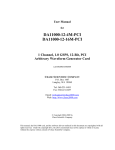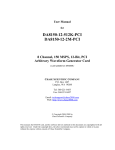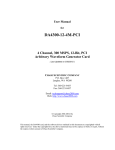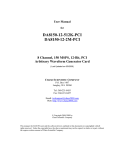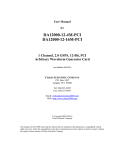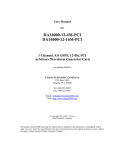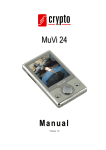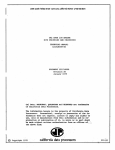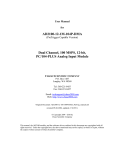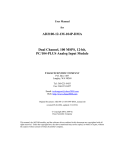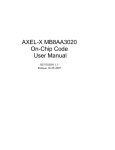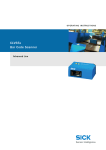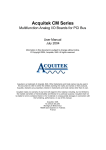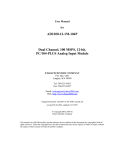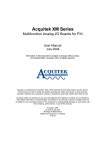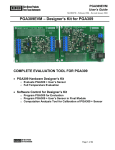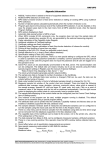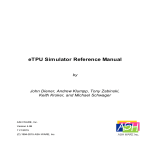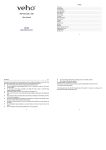Download "user manual"
Transcript
DA11000-4M DA11000-16M 1 Channel, 1 GS/s, 12-Bit, PCI Bus Arbitrary Waveform Generator Card User Manual February 2008 Information in this document is subject to change without notice. © Copyright 2004, Acquitek, SAS. All rights reserved. Acquitek is a trademark of Acquitek, SAS. Other trademarks and trade names may be used in this document to refer to either the entities claiming the marks and names or their products. Acquitek disclaims any proprietary interest in trademarks and trade names other than its own. Acquitek makes no warranty of any kind with regard to this material, including, but not limited to, the implied warranties of merchantability and fitness for a particular purpose. Acquitek shall not be liable for errors contained herein or for incidental or consequential damages in connection with the furnishing, performance, or use of this manual. Acquitek, SAS. 1 bis Rue Marcel Paul, 91300 Massy France Email: [email protected] Web: http://www.acquitek.com DA11000 User Manual 1-Ch, 1GS/s, PCI Arbitrary Waveform Generator TABLE OF CONTENTS 1 GENERAL INFORMATION.......................................................................................................................3 1.1 INTRODUCTION ............................................................................................................................................3 1.2 REFERENCES.................................................................................................................................................3 1.3 DELIVERABLES .............................................................................................................................................4 1.3.1 Software ......................................................................................................................................4 1.3.2 Hardware ....................................................................................................................................5 1.3.3 Checklist ......................................................................................................................................5 1.4 PRODUCT SPECIFICATION ...........................................................................................................................5 1.5 OPTION SUMMARY .......................................................................................................................................7 1.6 TECHNICAL SUPPORT / SOFTWARE UPDATES ...........................................................................................7 1.7 WARRANTY ...................................................................................................................................................8 2 HARDWARE DESCRIPTION...................................................................................................................9 2.1 2.2 2.3 2.4 3 THEORY OF OPERATION ......................................................................................................................11 3.1 3.2 4 INTRODUCTION ............................................................................................................................................9 BOARD DRAWING ........................................................................................................................................9 EXTERNAL CLOCK JUMPER CONFIGURATIONS .........................................................................................10 PCI MEMORY ALLOCATION .......................................................................................................................11 INTRODUCTION ..........................................................................................................................................11 DOWNLOADING AND OUTPUTTING USER DATA TO THE DA11000......................................................11 SOFTWARE DRIVERS .............................................................................................................................12 4.1 INTRODUCTION ..........................................................................................................................................12 4.2 DRIVER INSTALLATION WINDOWS 2000 / XP ......................................................................................12 4.3 FUNCTION CALLS .......................................................................................................................................13 4.3.1 C Header File for DLL .........................................................................................................13 4.3.2 Function Call Descriptions / Usage...........................................................................13 4.3.2.1 4.3.2.2 4.3.2.3 4.3.2.4 4.3.2.5 4.3.2.6 4.3.2.7 4.3.2.8 4.3.2.9 4.3.2.10 4.4 5 da11000_CountCards() ..................................................................................................................... 13 da11000_Open() .................................................................................................................................. 14 da11000_Close().................................................................................................................................. 14 da11000_SetClock() ........................................................................................................................... 15 da11000_SetTriggerMode() ............................................................................................................. 15 da11000_SetSoftTrigger()................................................................................................................ 16 da11000_SetMarkers() ...................................................................................................................... 17 da11000_CreateSingleSegment() ................................................................................................. 18 da11000_ CreateSegments() .......................................................................................................... 19 da11000_UpdateSegmentCmds () ................................................................................................ 21 PROGRAMMING EXAMPLES ........................................................................................................................22 MISCELLANEOUS ......................................................................................................................................24 5.1 5.2 CALIBRATION .............................................................................................................................................24 MAINTENANCE ............................................................................................................................................24 2 DA11000 User Manual 1 1-Ch, 1 GS/s, PCI Arbitrary Waveform Generator GENERAL INFORMATION 1.1 Introduction The DA11000 is a (1) Channel, 12-bit, 1 Giga Sample/second Arbitrary Waveform Generator on a single mid-sized PCI card. It comes standard with following general features: - Standard fixed clock 1 GHz. 12-bit Vertical Resolution (1) TTL Output Marker Programmable Segment Size from 64 Words to full memory Programmable Number of Segments up to 32K External TTL clock and External TTL trigger input The outputs consist of (1) 50 ohm SMA output. To provide maximum flexibility and performance to the user, the output comes unfiltered, although the output buffer BW is > 300 MHz at full scale. An appropriate low pass filter is generally added in-line for a particular application and can be bought from companies like Mini-Circuits or can be ordered and/or custom made directly from Acquitek. The DA11000 has TTL input triggering capability that allows a segment or segments of data to be output only after a trigger is present. Gating is also available which will start and stop the data from being output on high or low TTL levels respectively. An external TTL clock input allows the use of precision clock sources such and also for synchronizing multiple cards to a master clock. 1.2 References PCI Local Bus Specification, Rev. 2.1, June 1st, 1995. For more information on this document contact: PCI Special Interest Group P.O Box 14070 Portland, OR 97214 Phone (800) 433-5177 (U.S.) (503) 797-4207 (International) FAX (503) 234-6762 3 DA11000 User Manual 1-Ch, 1GS/s, PCI Arbitrary Waveform Generator 1.3 Deliverables 1.3.1 Software The DA11000 comes with DLL drivers for Windows 2000/XP. Software comes on a CD. Call Acquitek for the latest information on drivers for other operating system platforms. Windows 2K/XP software drivers are provided as a Dynamic Link Library (*.DLL) which is compatible with most 32-bit windows based development software including Microsoft C/C++, Borland C/C++, Borland Delphi, Visual Basic, LabVIEW and MATLAB script. This DLL uses the “cdecl” calling convention for maximum compatibility and was made using Borland C++ Builder. It automatically provides the interface to the system drivers “Windrvr6.sys” for Windows 98/ME/NT4/2000/XP. 4 DA11000 User Manual 1-Ch, 1 GS/s, PCI Arbitrary Waveform Generator 1.3.2 Hardware The DA11000 hardware consists of a single mid-sized PCI compliant card. The card is shipped with this manual which includes complete hardware and software descriptions. 1.3.3 Checklist Item # Qty Part Number 1 1 2 1 DA11000-12-4M-PCI Or DA11000-12-16M-PCI DA11000 Drivers 3 1 DA11000-Manual Description 1-CH, 1GS/sec Arbitrary Waveform Generator, PCI card. CD with Dynamic Link Libraries for Windows2K/XP. Includes standalone demo application and labView driver On CD User manual for DA11000. 1.4 Product Specification (all specifications are at 25 ºC unless otherwise specified) SPECIFICATIONS Parameter Analog Outputs Number of Outputs Output Coupling Vertical Resolution Amplitude Rise Time (10% to 90%) Fall Time (10% to 90%) Clock Jitter Internal Clock Rate Frequency Range Stability Memory Waveform # of User Segments Segment Size Range Digital Outputs (1) TTL Markers Conditions Typical Values unless otherwise indicated 1 GS/s (1) 50 ohm SMA output AC coupling through 50 ohm transformer 12 bits (1 part in 4096) 0.5Vpp +/-3%, single ended into 50 ohms. No Filters No Filters 1.0 GS/sec 300 pico sec typical into 50 ohms 300 pico sec typical into 50 ohms Less than 20 psec RMS at 300MHz T=0ºC – 70ºC Standard 1.0 GHz fixed 100 ppm 4M Words x 12-bits (or 16M Words) 1 to 16K segments 64 Words up to total memory in 64 Word increments Fclk/4 resolution 5 DA11000 User Manual 1-Ch, 1GS/s, PCI Arbitrary Waveform Generator Digital Inputs High Speed Clk input D/A rate 50 ohm SMA input (Sinewave from 0dBm to 6 dBm) Can only use the following frequencies: 1.0 GHz, 500 MHz, 250 MHz, and 125 MHz. (See section 2.4 for jumper settings) Low Speed Clk input 10 MHz Reference Only 50 ohm SMA input (Sine/Square wave from 0dBm to 10 dBm) (See section 2.4 for jumper settings) TTL Trigger input ENVIRONMENTAL Parameter Temperature Operating Non-Operating Humidity Operating Non-Operating Power +5V +3.3V +12V -12V Size DA11000-12-4M-PCI Used to initiate any memory segment programmed for that purpose. Typical Values unless otherwise stated 0 to 70 degrees C standard -40 to +85 degrees C extended 5 to 95% non-condensing 20% to 80% 5% to 95% +5V DC +/- 10% => 500mA, 2.5 Watts (Typical using worst case waveform) +3.3 VDC +/- 10% => 2.5 Amps, 8.4 Watts (Typical using worst case waveform) +12 VDC +/- 10% => 216mA, 2.6 Watts (Typical using worst case waveform) -12 VDC +/- 10% => 100mA, 1.2 Watts (Typical using worst case waveform) (1) Mid-Sized PCI Card 6 DA11000 User Manual 1-Ch, 1 GS/s, PCI Arbitrary Waveform Generator 1.5 Option Summary OPTION SUMMARY Option Name Option 3 Description Linux Driver 1.6 Technical Support / Software Updates For technical support: Phone: Fax: Email: Mail: +33 1 60 13 52 73 +33 1 60 13 03 68 [email protected] Acquitek 1 bis rue Marcel Paul, 91300 Massy, France For software updates: Email: Web: [email protected] http://www.acquitek.com 7 DA11000 User Manual 1-Ch, 1GS/s, PCI Arbitrary Waveform Generator 1.7 Warranty Acquitek warrants to the original purchaser that it’s DA11000, and the component parts thereof, will be free from defects in workmanship and materials for a period of ONE YEAR from the data of purchase. Acquitek will, without charge, repair or replace at its option, defective or component parts upon delivery to Acquitek service department within the warranty period accompanied by proof of purchase date in the form of a sales receipt. EXCLUSIONS: This warranty does not apply in the event of misuse or abuse of the product or as a result of unauthorized alterations or repairs. It is void if the serial number is altered, defaced or removed. Acquitek shall not be liable for any consequential damages, including without limitation damages resulting from loss of use. Some states do not allow limitation or incidental or consequential damages, so the above limitation or exclusion may not apply to you. This warranty gives you specific rights. You may also have other rights that vary from state to state. NOTICE: Acquitek reserves the right to make changes and/or improvements in the product(s) described in this manual at any time without notice. 8 DA11000 User Manual 2 1-Ch, 1 GS/s, PCI Arbitrary Waveform Generator HARDWARE DESCRIPTION 2.1 Introduction The DA11000 hardware consists of the following major connections: • (1) 1 Giga Samples/second, 12-bit analog outputs (SMA) • • • PECL/Sinewave Clock Input, 125MHz, 250MHz, 500MHz, 1.0 GHz ONLY (AC coupled) (1) TTL Trigger input (SMA) (1) TTL Marker output (SMA) 2.2 Board Drawing 9 DA11000 User Manual 1-Ch, 1GS/s, PCI Arbitrary Waveform Generator 2.3 External Clock Jumper Configurations JP2 (pinout) JUMPER 1 1 2 JUMPER 2 3 4 JUMPER 3 5 6 JUMPER 4 7 8 Clock Configuration Table #1 Jumper #2 Jumper #3 Jumper #4 Use 1.0 GHz Internal Clock locked to internal 10 MHz reference SHORT OPEN OPEN SHORT Use External Clock at D/A clock rate OPEN SHORT OPEN SHORT SHORT OPEN SHORT OPEN Jumper Allowable rates = 1.0 GHz, 500 MHz, 250 MHz Lock to External 10 MHz Reference DA11000 Phase locks the internal 1.0 GHz master clock to external 10 MHz Reference External Clock Input Notes High Speed Clk input D/A rate 50 ohm SMA input (Sinewave from 0dBm to 6 dBm) Can only use the following frequencies: 1.0 GHz, 500 MHz, 250 MHz, and 125 MHz. Low Speed Clk input 10 MHz Reference Only 50 ohm SMA input (Sine/Square wave from 0dBm to 10 dBm) 10 DA11000 User Manual 1-Ch, 1 GS/s, PCI Arbitrary Waveform Generator 2.4 PCI Memory Allocation DA11000 on-board memory is mapped automatically when a PCI 2.1 (or newer) motherboard powers up. If the DA11000 has 4 Mega Samples of memory, then the motherboard will allocate 8 Megabytes of memory. Once installed, the DA11000 software drivers will find the board or boards without the user changing any jumpers or worrying about addressing. How the memory is allocated and where it is located in the system is completely transparent, unless the user manages to use up the entire memory available to the PCI motherboard (usually 256 Megabytes or more). 3 THEORY OF OPERATION 3.1 Introduction Although the DA11000 is primarily comprised of a Segment Sequencer (or memory manager) and a 4:1 High Speed Multiplexer, it’s how the software interacts with the hardware that makes it work. The following sections should provide enough operational theory for better understanding when using the software drivers. 3.2 Downloading and Outputting User Data to the DA11000 The DA11000 RAM memory IC’s not only contain the user’s waveform data, but it also contains special command codes that run the Segment Sequencer. These codes are placed into the upper nibble (4 bits) of selected individual sample points (16 bit words), leaving the lower 12 bits for user data. The Segment Sequencer reads these codes to determine where and when to jump to another segment, how many times to loop, when to wait for a trigger, and when to shut down. This is the heart of the DA11000 memory management. Downloading a Single User Waveform (single segment) into memory is performed by simply calling da11000_CreateSingleSegment(DWORD NumPoints, DWORD NumLoops, PVOID UserArrayPtr, DWORD TrigEn). The user must be sure to pass the size of the waveform (NumPoints), the number of times to repeat the waveform (NumLoops), a pointer variable pointing to the user array containing the data (UserArrayPtr), and finally, whether the segment will be self triggered or triggered by an external signal (TrigEn). Downloading Multiple Linked Waveform Segments is performed by calling da11000_CreateSegments(DWORD NumSegments, PVOID PtrToSegmentsList). This function call requires the user to create a structure containing all the critical information on the segments that the user wants to download. The actual structure for each segment looks like the following: typedef struct { DWORD PVOID SegmentNum; SegmentPtr; DWORD NumPoints; DWORD NumLoops; DWORD BeginPadVal; DWORD EndingPadVal; DWORD TrigEn; DWORD NextSegNum; ativities } SegmentStruct; // Current Segment Number // Pointer to current user segment // ==> elements of one diminsional array must be of type WORD // Number of points in segment // Number of times to repeat segment (applies to next segment) // Pad value for beginning of triggered segment // Pad value for ending of triggered segment // If > 0 then wait for trigger before going to next segment. // Next segment to jump to after completion of current segment 11 DA11000 User Manual 1-Ch, 1GS/s, PCI Arbitrary Waveform Generator The user must create an array of these segments and pass the pointer (PtrToSegmentsList) to the function call. After the appropriate waveform data has been downloaded to the DA11000, da11000_SetTriggerMode() is enabled and the output begins. 4 SOFTWARE DRIVERS 4.1 Introduction Our primary objective in designing software drivers is to get the user up and running as quickly as possible. While the details on individual function calls are listed in sections 4.2.xx, the programming examples in section 4.3.x will show you how to include them into your programs. Please note that function calls are the same whether you are calling them under Windows 95, 98, NT, 2k or XP. 4.2 Driver Installation Windows 2000 / XP Be aware that we use the same driver for the DA4300 card. 1) Do not install DA11000 card at this time. 2) Run the setup located on the CD This will copy the Kernel driver windrvr6.sys to "c:\<windir>\system32\drivers\" directory and will register the Kernel driver in the Windows Registry so that it starts up each time the computer is rebooted. It installs also a standalone demo software called DA11000 demo. 4) Power off computer, insert DA4300 card and Power up the computer. 5) When OS asks for Driver File point to "DA11000.inf" which is located on the CD root (or on your DA11000 installation directory . If OS does not ask for file, then check hardware configuration and update if not listed properly under "Jungo" in Device Manager (see below). To check to see which driver is installed, do the following: => Control Panel => System => Hardware => Device Manager => Jungo DA11000 (Both this and WinDriver below should be present) WinDriver If you see another driver in place of " DA11000 ", then right click the first device under Jungo and click properties. Update the driver by pointing to "DA11000 ". You may have to go through a series of menus. 12 DA11000 User Manual 1-Ch, 1 GS/s, PCI Arbitrary Waveform Generator 4.3 Function Calls 4.3.1 C Header File for DLL //--------------------------------------------------------------------------// USER ROUTINES //--------------------------------------------------------------------------#define IMPORT extern "C" __declspec(dllimport) IMPORT DWORD da11000_CountCards(void); IMPORT DWORD da11000_Open(DWORD CardNum); IMPORT DWORD da11000_Close(DWORD CardNum); IMPORT void da11000_SetClock(DWORD CardNum, DWORD Frequency); IMPORT void da11000_SetTriggerMode(DWORD CardNum, BYTE Mode, BYTE ExtPol); IMPORT void da11000_SetSoftTrigger(DWORD CardNum); IMPORT void da11000_SetMarkers(DWORD CardNum, DWORD PointAddr, BYTE Nib1, BYTE Nib2); IMPORT void da11000_CreateSingleSegment(DWORD CardNum, DWORD ChanNum, DWORD NumPoints, DWORD NumLoops, PVOID UserArrayPtr, DWORD TrigEn); IMPORT void da11000_CreateSegments(DWORD CardNum, DWORD NumSegments, PVOID UserSegmentsPtr); IMPORT void da11000_UpdateSegmentCmds(DWORD CardNum, DWORD NumSegments, PVOID PtrToSegmentsList); 4.3.2 Function Call Descriptions / Usage 4.3.2.1 da11000_CountCards() Description Returns number of DA11000 cards present on computer. Declaration DWORD da11000_CountCards(void); Parameters none Return Value Returns with an encoded value which represents the number of DA11000. Return Values: 1-4: Number of DA11000 boards detected. 0: Indicates that no boards were found but that drivers are working properly. 13: Software drivers are not installed properly. Example DWORD Num_da11000_Boards = da11000_CountCards(); 13 DA11000 User Manual 4.3.2.2 1-Ch, 1GS/s, PCI Arbitrary Waveform Generator da11000_Open() Description Loads the DA11000 software drivers and sets the DA11000 board to its default state. Declaration DWORD da11000_Open(DWORD CardNum); Parameters CardNum: 1 <= CardNum <= 4 Return Value Returns with error code. A "0" means everything is fine. See below for details for other values. Return Values: 0: Opened Windriver Successfully and DA11000 Card Found Successfully 1: Opened Windriver Successfully, but NO DA11000 CARDS FOUND 2: Opened Windriver Successfully, Card found, but unable to open. 3: Opened Windriver Successfully, Board already open. 6: Card number exceeds number of cards. 13: FAILED TO OPEN Windriver Kernel Driver Example DWORD OpenErrorCode = da11000_Open(1); // Opens Board Number 1 and stores value. 4.3.2.3 da11000_Close() Description Closes DA11000 drivers. Should be called after finishing using the driver. However, if no other software uses the “windrv.xxx” (usual situation), then there is no need to close it until user is ready to completely exit from using their main software program which calls “windrv.xxx”. If the user is loading the “windrv.xxx” dynamically (during run time), then they should close before unloading the driver. Declaration DWORD da11000_Close(DWORD CardNum); Parameters CardNum: 1 <= CardNum <= 4 14 DA11000 User Manual 1-Ch, 1 GS/s, PCI Arbitrary Waveform Generator Return Value Returns with error code. A "0" means everything is fine. See below for details for other values. Return Values: 0: Closed Windriver Successfully for DA11000 card requested. 5: DA11000 Card Already Closed for card requested. 13: FAILED TO ACCESS Windriver Kernel Driver Example DWORD CloseErrorCode = da11000_Close(1); 4.3.2.4 da11000_SetClock() Description Sets the Digital to Analog converter clock rate. This function does nothing (placeholder) at this time on the DA11000. The card is fixed at 1.0 GSPS. There are jumpers on the PCB to allow for external clock features (see section 2.3). Declaration void da11000_SetClock(DWORD CardNum, DWORD Frequency); Parameters CardNum: 1 <= CardNum <= 4 Frequency: 1000000000 Only one Frequency is allowed. Return Value none Example da11000_SetClock(1e9); // Sets clock rate to 1 GHz. 4.3.2.5 da11000_SetTriggerMode() Description Sets triggering modes. This command should be called (using mode=0) just after the driver is opened to initialize internal hardware registers before calling any other routines. This function also selects whether board is in triggered mode or not and polarity of external TTL triggered signal. Declaration void da11000_SetTriggerMode(DWORD CardNum, BYTE Mode, BYTE ExtPol); 15 DA11000 User Manual Parameters CardNum: 1-Ch, 1GS/s, PCI Arbitrary Waveform Generator 1 <= CardNum <= 4 Mode: 0: Shuts down all output operations. Asynchronously resets RAM address counter and repeat counters to zero. 1: Used for starting single segment operation for segment created with “da11000_CreateSingleSegment()”. Repeats indefinitely until mode set back to 0. External or “soft” trigger has no effect in this mode. Also works for “da11000_CreateSegments()”, but any segments specified as triggered will immediately jump to next segment (no trigger required) and beginning and ending pads will be present in output for these segments. 2: Sets up first segment for external or “soft” trigger mode. Individual segment(s) created as triggered will wait until external or soft trigger has occurred. If segment was created not to be triggered, then segment will follow previous segment in a continuous fashion (no trigger needed). See da11000_CreateSegments for more information on multi-segment functioning. ExtPol: 0: Trigger is initiated on RISING edge of TTL waveform. 1: Trigger is initiated on FALLING edge of TTL waveform. Return Value none Example da11000_SetTriggerMode(2,0); // First segment will wait for trigger before running. 4.3.2.6 da11000_SetSoftTrigger() Description Emulates external triggering in software. Since this function actually toggles polarity of external input signal, it is “ORed” with external signal. Declaration void da11000_SetSoftTrigger(DWORD CardNum); Parameters none Return Value none Example da11000 SetSoftTrigger(1); // Initiates software trigger on Card Number 1 16 DA11000 User Manual 4.3.2.7 1-Ch, 1 GS/s, PCI Arbitrary Waveform Generator da11000_SetMarkers() Description Sets up TTL output marker locations relative to waveform memory. It is up to the user to place the markers correctly. There is always a startup 64 sample leading pad when a waveform first outputs. Please note that all segments have a 64 sample leading pad and a 64 sample trailing pad, regardless of whether they repeat or not. Resolution of the markers is 1/4 of the clock rate. Also, please note that this function call must be called after creating any segments since da11000_ CreateSegments() and da11000_CreateSingleSegment() will overwrite the markers with zeros if done in the reverse order. Declaration void da11000_SetMarkers(DWORD CardNum, DWORD PointAddr, BYTE Nib1, BYTE Nib2); Parameters CardNum: 1 <= CardNum <= 4 PointAddr: RAM address location. Minimum resolution is 4 clock samples. Nib1: 0 <= Nib1 <= 0xF [ see board layout for connector information ] Nib2: 0 <= Nib2 <= 0xF (Nib2 is unused since only one TTL marker is available) Return Value None. Example da11000_SetMarkers(1, 64, 0xF, 0xF); // Place marker on all bits at // beginning of 1st data segment of // board number 1. Return Value none 17 DA11000 User Manual 4.3.2.8 1-Ch, 1GS/s, PCI Arbitrary Waveform Generator da11000_CreateSingleSegment() Description Creates a single segment in memory. The user determines the size of the array and whether the segment is started automatically or waits for an external input trigger. After creating a single segment waveform, the user must call SetTriggerMode() to turn on/off output waveforms. In triggered mode there is a 64 samples of pad at the beginning and end of the segment with a level set at 2047. In non-triggered mode the only pad that is visible is the beginning pad when the output is started, then repeats data portion indefinitely until reset. All segments, regardless of whether it’s triggered or not, have 64 sample pads at the beginning and end of the segments in actual memory, but may not be visible depending on whether the segment is triggered or not. See "da11000_CreateSegments()" for generating multiple segments. Declaration void da11000_CreateSingleSegment(DWORD CardNum, DWORD ChanNum, DWORD NumPoints, DWORD NumLoops, PVOID UserArrayPtr, DWORD TrigEn); Parameters CardNum: ChanNum: NumPoints: NumLoops: 1 <= CardNum <= 4 1 64 <= NumPoints <= (MaxMem-128) [ Must be in multiples of 64 ] Note that NumPoints should be the same for each channel. The four channels have always the same length. Set to 0 (other values not available) [0 = Continuous] UserArrayPtr: Pointer to user array of WORD TrigEn: High enables external trigger (must also set da11000_SetTriggerMode to triggered) Return Value None. Raw data conversion: 4095 Î min output voltage (-250mV in 50 ohm) 2047 Î zero (0V) 0 Î max output voltage (+250mV in 50 ohm) Example da11000_CreateSingleSegment(1, 2, 128, 0, UserArrayPointer, 0); // // // // // // Card Number 1 Channel 2 128 Words contained Loops continuously Pointer to user data External trigger not enabled 18 DA11000 User Manual 4.3.2.9 1-Ch, 1 GS/s, PCI Arbitrary Waveform Generator da11000_ CreateSegments() Description Creates any number of segments up to the size of memory. All segments have 64 samples of beginning pad and 64 samples of trailing pad which the user cannot access except to determine the default levels. However, when repeating or jumping in non-triggered mode, the user will not see the pad fields. Each segment can be programmed for repeat counts up to 16K and can jump to any other segment. See below for data structures for creating user segments. User must provide the correct array structures and pass a pointer to it along with how many sequential segments are desired to be used. After creating a complete waveform, the user must call SetTriggerMode() to turn on/off output waveforms. Declaration void da11000_CreateSegments(DWORD CardNum, DWORD ChanNum, DWORD NumSegments, PVOID PtrToSegmentsList); Parameters CardNum: ChanNum: 1 <= CardNum <= 4 1 NumSegments: PtrToSegmentsList: typedef struct { DWORD PVOID Number of segment structures (see below) which user has defined and wants to use. Pointer to user array with each element with structure defined as shown below. SegmentNum; SegmentPtr; DWORD NumPoints; DWORD NumLoops; DWORD BeginPadVal; DWORD EndingPadVal; DWORD TrigEn; DWORD NextSegNum; activities } SegmentStruct; // Current Segment Number // Pointer to current user segment // ==> elements of one dimensional array must be of type WORD // Number of points in segment (MUST BE MULTIPLE OF 64 ) // Number of times to repeat segment (applies to next segment) // Pad value for beginning of triggered segment // Pad value for ending of triggered segment // If > 0 then wait for trigger before going to next segment. // Next segment to jump to after completion of current segment **** Note that a segment is determined to be a triggered segment by the previous segment. So setting Segment 5 as triggered will stop the sequence after Segment 5 has executed and will wait for trigger event before “NextSegNum” is started. The first segment is a special case and is determined by default as a triggered type if SetTriggerMode() is set to “mode=2”. The user in this case may use an external trigger or a “soft” trigger to initiate the output process. Return Value: none. Example 19 DA11000 User Manual 1-Ch, 1GS/s, PCI Arbitrary Waveform Generator // Create Array for SegmentList and Segments SegmentStruct SegmentsList[2]; WORD Segment0_Data[64]; WORD Segment1_Data[64]; // Create Segment #1 for (i=0; i < (64); i++) { Segment0_Data[i] = ceil( 2047.0 - 2047*cos( 2*pi*i/(32) ) ); } SegmentsList[0].SegmentNum = 0; SegmentsList[0].SegmentPtr = Segment0_Data; SegmentsList[0].NumPoints = 64; SegmentsList[0].NumLoops = 0; SegmentsList[0].BeginPadVal = 2047; SegmentsList[0].EndingPadVal = 2047; SegmentsList[0].TrigEn = 0; SegmentsList[0].NextSegNum = 1; // Create Segment #2 for (i=0; i < (64); i++) { Segment1_Data[i] = ceil( 2047.0 - 2047*cos( 2*pi*i/(8) ) ); } SegmentsList[1].SegmentNum = 1; SegmentsList[1].SegmentPtr = Segment1_Data; SegmentsList[1].NumPoints = 64; SegmentsList[1].NumLoops = 0; SegmentsList[1].BeginPadVal = 1000; SegmentsList[1].EndingPadVal = 1000; SegmentsList[1].TrigEn = 1; SegmentsList[1].NextSegNum = 0; // Loops back to 1 da11000_CreateSegments(1,1,2,SegmentsList); 20 DA11000 User Manual 4.3.2.10 1-Ch, 1 GS/s, PCI Arbitrary Waveform Generator da11000_UpdateSegmentCmds () Description This function call works that same as “da11000_CreateSegments()” except that it does not download the data from system memory to card memory. Only the sequence commands are downloaded to the card’s memory. This saves time when the user wants to change the order of the segments because the segment data does not have to be updated. (The microcommands tell the memory sequencer how many times to loop, when to jump, etc. ) Declaration void da11000_UpdateSegmentCmds(DWORD CardNum, DWORD ChanNum, DWORD NumSegments, PVOID PtrToSegmentsList); Parameters CardNum: 1 <= CardNum <= 4 ChanNum: 1 NumSegments: Number of segment structures (see below) which user has defined and wants to use. PtrToSegmentsList: Pointer to user array with each element with structure defined as shown below. typedef struct { DWORD SegmentNum; PVOID SegmentPtr; // Current Segment Number // Pointer to current user segment // ==> elements of one diminsional array must be of type WORD DWORD NumPoints; // Number of points in segment DWORD NumLoops; // Number of times to repeat segment (applies to next segment) DWORD BeginPadVal; // Pad value for beginning of triggered segment DWORD EndingPadVal; // Pad value for ending of triggered segment DWORD TrigEn; // If > 0 then wait for trigger before going to next segment. DWORD NextSegNum; // Next segment to jump to after completion of current segment activities } SegmentStruct; **** Note that a segment is determined to be a triggered segment by the previous segment. So setting Segment 5 as triggered will stop the sequence after Segment 5 has executed and will wait for trigger event before “NextSegNum” is started. The first segment is a special case and is determined by default as a triggered type if SetTriggerMode() is set to “mode=2”. The user in this case may use an external trigger or a “soft” trigger to initiate the output process. Return Value: none. Example See da11000_CreateSegments() above for example. 21 DA11000 User Manual 1-Ch, 1GS/s, PCI Arbitrary Waveform Generator 4.4 Programming Examples Example Program // // DA11000 DLL C Example Test File // ====================================== // // 32-bit Borland C++ 5.0 // // #include #include #include #include <stdio.h> <stdlib.h> <string.h> <math.h> #include "da11000_dll_import.h" #pragma link "da11000_dll_borland.lib" int main(int argc, char **argv) { WORD TempArray[1048575]; int NumCards = 0; DWORD MemoryDepth = 1048576 double pi = 3.14159265358979; // Check to see if card available NumCards = da11000_CountCards(); // Counts number of DA11000 cards // OPEN DRIVER if (NumCards > 0) then DWORD OpenErrorCode = da11000_Open(1); else exit(0); // Else exits // INITIALIZE BOARD da11000_SetTriggerMode(1,0,0); // Opens card # 1 // VERY IMPORTANT !!! // PUT WAVEFORM INTO ARRAY for (DWORD i=0; i < (MemoryDepth); i++) { TempArray[i] = ceil( 2047.0 - 2047*cos( 2*pi*i/(64) ) ); } // CREATE SINGLE SEGMENT WITH INFINITE LOOP da11000_CreateSingleSegment(1,1,MemoryDepth, 0, TempArray, 0); // OUTPUT DATA da11000_SetTriggerMode(1,1,0); // Enables out of data on brd# 1 // SHUT DOWN OUTPUT // da11000_SetTriggerMode(1,0,0); // Use this to shut down output on brd# 1 // CLOSE DRIVER if (NumCards > 0) da11000_Close(1); // Closes brd# 1. } 22 DA11000 User Manual 1-Ch, 1 GS/s, PCI Arbitrary Waveform Generator Header File (for Reference) //--------------------------------------------------------------------------#ifndef da11000_dllH #define da11000_dllH //--------------------------------------------------------------------------//--------------------------------------------------------------------------// USER ROUTINES //--------------------------------------------------------------------------#define IMPORT extern "C" __declspec(dllimport) IMPORT DWORD da11000_CountCards(void); IMPORT DWORD da11000_Open(DWORD CardNum); IMPORT DWORD da11000_Close(DWORD CardNum); IMPORT void da11000_SetClock(DWORD CardNum, DWORD Frequency); IMPORT void da11000_SetTriggerMode(DWORD CardNum, BYTE Mode, BYTE ExtPol); IMPORT void da11000_SetSoftTrigger(DWORD CardNum); IMPORT void da11000_SetMarkers(DWORD CardNum, DWORD PointAddr, BYTE Nib1, BYTE Nib2); IMPORT void da11000_CreateSingleSegment(DWORD CardNum, DWORD ChanNum, DWORD NumPoints, DWORD NumLoops, PVOID UserArrayPtr, DWORD TrigEn); IMPORT void da11000_CreateSegments(DWORD CardNum, DWORD ChanNum, DWORD NumSegments, PVOID PtrToSegmentsList); IMPORT void da11000_UpdateSegmentCmds(DWORD CardNum, DWORD ChanNum, DWORD NumSegments, PVOID PtrToSegmentsList); #endif 23 DA11000 User Manual 5 1-Ch, 1GS/s, PCI Arbitrary Waveform Generator MISCELLANEOUS 5.1 Calibration The DA11000 has no user feature to calibrate. The gains and offsets are calibrated at the factory to be within specifications at 25ºC and nominal voltages. 5.2 Maintenance No maintenance is required. However, a yearly calibration is recommended if the user desires to maintain the DA11000 specified accuracy. Call factory for maintenance and/or extended warranty information. Trademarks: MS-DOS, Windows 3.1, Windows 95, Windows NT and Windows XP are registered trademarks of Microsoft Corporation. 24
























